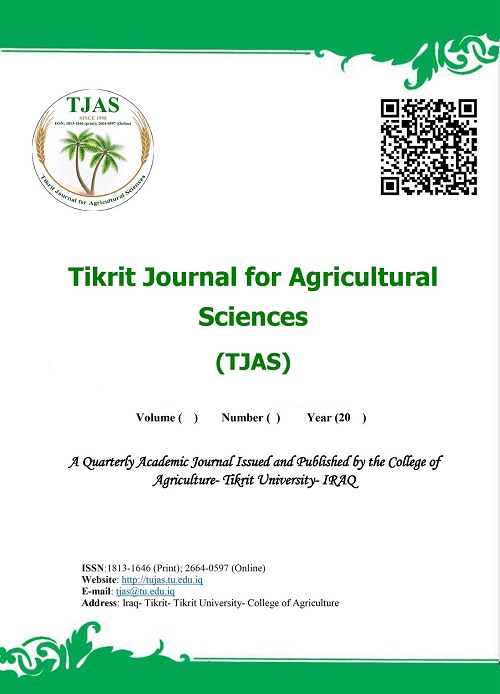Abstract
This research included study the capacity of Typha domengensis and Phragmites communis plants in bioremediation for removing some antibiotics as one of pollutants discard to Waste Water for Samarra Drug Industry (SDI) two antibiotics had selected (Cephalexin and Amoxicillin) because their amounts is the greater according to production during study period. Two stations had Selected for test, The first station of exist plants inside Samarra drug industry and the second station of plants exist on the edge of the Tigris river as control station. The study included the evaluation of antibiotics, chlorophyll A and B, proteins and carbohydrates in plants.
The results of the plants indicated that the concentrations of antibiotics in the first station ranged between (0.002-0.089) mg / ml for cephalexin and (Nil-0.001) mg / ml for amoxicillin in reeds, and results ranged between (0.001-0.095) mg / ml for cephalexin and was not significant (Nil) for amoxicillin in papyrus, and no antibiotic value (Nil) was recorded at the second station. The values of chlorophyll A ranged (0.18-1.09), (0.12-0.89) mg / L at the first and second stations respectively, as well as the values of chlorophyll B ranged between (0.36-2.38), (0.28-1.46) mg / L for reeds, There was also variability in papyrus, with values of chlorophyll a (0.05-0.99), (0.17-1.92) mg / L and chlorophyll B ranged between (0.20-1.67), (0.40-1.76) mg / L for both stations respectively, The values of the proteins in the reeds ranged between (250-783), (184-680) µg/L respectively, and in the papyrus were (330-673), (280-726) µg/L for the two stations respectively, Carbohydrate values in reeds ranged between (0.16-2.60), (0.11-2.57) mg/L respectively, and in the papyrus was between (0.15-2.88), (0.13-2.59) mg/L respectively.
The results of the plants indicated that the concentrations of antibiotics in the first station ranged between (0.002-0.089) mg / ml for cephalexin and (Nil-0.001) mg / ml for amoxicillin in reeds, and results ranged between (0.001-0.095) mg / ml for cephalexin and was not significant (Nil) for amoxicillin in papyrus, and no antibiotic value (Nil) was recorded at the second station. The values of chlorophyll A ranged (0.18-1.09), (0.12-0.89) mg / L at the first and second stations respectively, as well as the values of chlorophyll B ranged between (0.36-2.38), (0.28-1.46) mg / L for reeds, There was also variability in papyrus, with values of chlorophyll a (0.05-0.99), (0.17-1.92) mg / L and chlorophyll B ranged between (0.20-1.67), (0.40-1.76) mg / L for both stations respectively, The values of the proteins in the reeds ranged between (250-783), (184-680) µg/L respectively, and in the papyrus were (330-673), (280-726) µg/L for the two stations respectively, Carbohydrate values in reeds ranged between (0.16-2.60), (0.11-2.57) mg/L respectively, and in the papyrus was between (0.15-2.88), (0.13-2.59) mg/L respectively.
Keywords
Bioremediation
Phragmites
Plant
Samarra Drug industry
Typha.
waste water
Abstract
تضمن البحث دراسة القدرة الحيوية لنباتي القصب والبردي للتخلص من بعض المضادات الحيوية كأحد الملوثات المطروحة مع مياه فضلات معمل ادوية سامراء، تم اختيار نوعين من المضادات الحيوية السيفالكسين Cephalexin والاموكسيسلين Amoxicillin كونها الاكثر من حيث الانتاج خلال فترة البحث. تم اختيار محطتين للقياس الاولى من النباتات المتواجدة داخل معمل ادوية سامراء والمحطة الثانية من النباتات المتواجدة على حافة نهر دجلة كمحطة سيطرة. شملت الدراسة قياس المضادات الحيوية، الكلوروفيل أ ، ب ، البروتينات، الكاربوهيدرات في النباتات. واشارت النتائج الى ان تراكيز المضادات الحيوية في نباتات المحطة الاولى تراوحت بين (0.002-0.089) ملغم/مل للسيفالكسين و(Nil -0.001) ملغم/مل للاموكسيسلين في القصب، وتراوحت بين (0.001-0.095) ملغم/مل للسيفالكسين وغير محسوسة (ND) للاموكسيسلين في البردي، لم تسجل اي قيمة للمضادات الحيوية (ND) في المحطة الثانية. كما وتباينت قيم كلوروفيل أ بين (0.18-1.09)،(0.12-0.89) ملغم/لتر في المحطة الاولى والثانية على التتابع، وكذلك قيم كلوروفيل ب بين (0.36-2.38)،(0.28-1.46) ملغم/لتر لنبات القصب، كما وسجلت كذلك تباينا في البردي اذ تراوحت قيم كلوروفيل أ بين (0.05-0.99)،(0.17-1.92) ملغم/لتر، والكلوروفيل ب تراوحت بين (0.20-1.67)،(0.40-1.76) ملغم/لتر للمحطتين على التتابع، كما وتباينت قيم البروتينات في القصب بين (250-783)،(184-680) مايكرو غرام/لتر، وفي البردي كانت بين (330-673)،(280-726) مايكرو غرام/لتر للمحطتين على التتابع، وكذلك قيم الكاربوهيدرات في القصب بين (0.16-2.60)، (0.11-2.57) ملغم/لتر، وفي البردي كانت (0.15-2.88)،(0.13-2.59) ملغم/لتر للمحطتين على التتابع.
Keywords
النبات، مياه الصرف، معمل ادوية سامراء، التحلل الحيوي، القصب، البردي.
